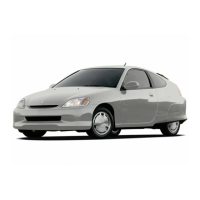
Do you have a question about the Honda Insight 2004 and is the answer not in the manual?
| Brand | Honda |
|---|---|
| Model | Insight 2004 |
| Category | Automobile |
| Language | English |
Key safety recommendations are presented on this page for immediate attention.
Details vehicle features that protect occupants during a crash.
Explains the importance of seat belts and how to wear them properly.
Provides essential information about airbags, including hazards and proper use.
Instructions on adjusting seats, seat belts, and proper sitting position.
Guidance for pregnant individuals on seat belt use and driving.
Further safety tips related to seat belts and airbags.
Details about seat belt system components, operation, and maintenance.
Information on airbag system components, operation, and service.
General guidelines for safely restraining children in the vehicle.
Explains the risks of carrying children due to airbag hazards.
Details the potential dangers of the passenger airbag to children.
Specific advice on restraining small children, including child seat types.
Guidelines for properly restraining larger children and checking seat belt fit.
Information on the dangers of carbon monoxide and how to avoid exposure.
Explains the purpose and location of safety warning labels.
Identifies the location of various controls and displays in the vehicle.
Explains various indicators on the instrument panel and their meanings.
Details the various gauges on the instrument panel, such as speed, fuel, and temperature.
Shows the location of controls on or near the steering wheel.
Details how to operate turn signals and headlights.
Covers the use of keys, door locks, and hatch locks.
Explains how to operate the power windows.
Instructions on adjusting the vehicle's mirrors.
Details how to apply and release the parking brake.
Describes various interior convenience features like storage and holders.
Explains how to use the climate control system for heating and cooling.
Instructions on operating the vehicle's radio, including tuning and presets.
Steps for playing a compact disc in the vehicle's CD player.
Information on operating the optional CD changer.
Information on how the audio system's anti-theft feature works.
Instructions for setting the vehicle's clock.
Guidance for the first 600 miles to ensure reliability and performance.
Information on recommended gasoline and octane rating for optimal performance.
Step-by-step instructions for refueling and opening the hood.
Tips for improving fuel economy and saving fuel through driving habits.
Guidance on safely carrying cargo, including load limits and storage.
Checks and adjustments to make before starting to drive the vehicle.
Instructions for starting the engine under various conditions.
Information on operating the manual transmission, including shifting.
Details on operating the Continuously Variable Transmission, including modes and indicators.
Guidelines for parking the vehicle safely in different situations.
Explanation of the vehicle's braking system, including ABS and wear indicators.
Safety precautions to follow when performing maintenance on the vehicle.
Recommended service intervals for normal and severe driving conditions.
Diagrams showing the location of various vehicle fluid reservoirs and caps.
Instructions for adding engine oil and recommended oil types.
Steps for changing engine oil and oil filter, including required tools.
Information on using, checking, and adding Honda antifreeze/coolant.
Instructions for checking automatic and manual transmission fluid levels.
How to replace front and rear wiper blades.
Information on tire inspection, inflation, rotation, and replacement.
How to check the battery's condition, terminals, and test indicator.
Information on using and maintaining the compact spare tire, including precautions.
Step-by-step guide for safely changing a flat tire.
Troubleshooting steps when the engine does not start or operate correctly.
Procedure for safely jump starting a vehicle with a dead battery.
What to do if the engine temperature gauge indicates overheating.
Explanation of the low oil pressure warning light and immediate actions.
Explains the check engine light, its causes, and potential damage from driving.
What the brake system warning light indicates and actions to take for safety.
Guidelines for safely towing the vehicle in emergencies.
How to check and replace blown fuses to restore electrical functions.
Locations of Vehicle Identification Number (VIN) and other important vehicle identifiers.
Key dimensions, capacities, engine, and tire specifications for the vehicle.
Explanation of tire grading for treadwear, traction, and temperature performance.
Overview of the vehicle's emissions control systems and their function.
Information on emissions testing requirements and readiness code preparation.
Contact information for customer service and dealership support.
Overview of different warranties covering the vehicle and its components.
How to report potential safety defects to NHTSA and the manufacturer.












